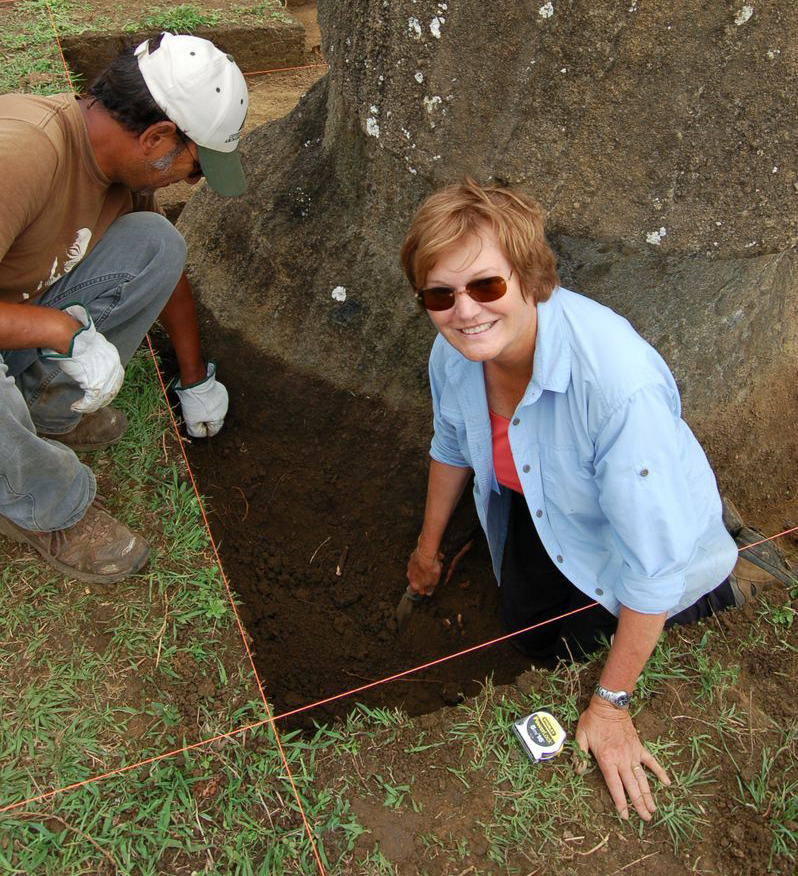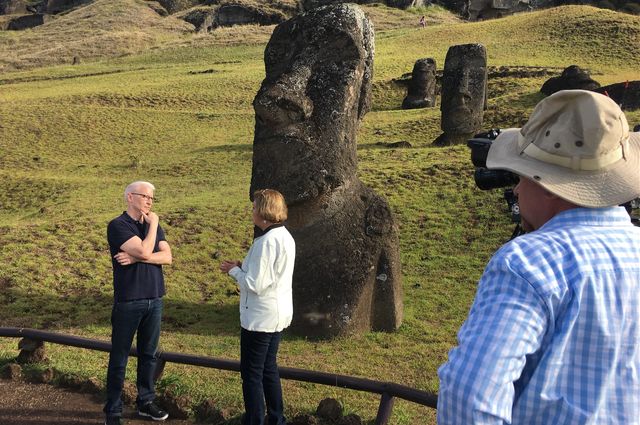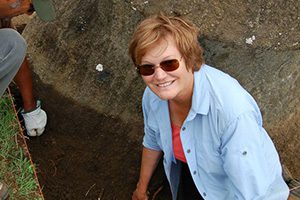The stone faces and human problems on Easter Island

Jo Anne Van Tilburg, right, and Cristián Arévalo Pakarati. Photo credit: Easter Island Statue Project
In 1981, archaeology graduate student Jo Anne Van Tilburg first set foot on the island of Rapa Nui, commonly called Easter Island, eager to further her interest in rock art by studying the iconic stone heads that enigmatically survey the landscape.
At the time, Van Tilburg was one of just a few thousand people who would visit Rapa Nui each year. Although the island remains one of the most remote inhabited islands in the world, a surge in visitors has placed its delicate ecosystem and archaeological treasures in jeopardy.
“When I went to Easter Island for the first time in ’81, the number of people who visited per year was about 2,500,” said Van Tilburg, director of the Easter Island Statue Project, the longest collaborative artifact inventory ever conducted on the Polynesian island that’s part of Chile. “As of last year the number of tourists who arrived was 150,000.”
Journalist Anderson Cooper interviewed Van Tilburg on the island for a segment that aired Easter Sunday on CBS’ 60 Minutes. Cooper spoke with Van Tilburg about efforts to preserve the moai (pronounced MO-eye) — the monolithic stone statues that were carved and placed on the island from around 1100 to 1400 and whose stoic faces have fascinated the world for decades. In 1995, UNESCO named Easter Island a World Heritage Site, with much of the island protected within Rapa Nui National Park.
Van Tilburg, who is research associate at the UCLA Cotsen Institute of Archaeology and director of UCLA’s Rock Art Archive since 1997, was the first archaeologist since the 1950s to obtain permission to excavate the moai, granted from Chile’s National Council of Monuments and the Rapa Nui National Park, with the Rapa Nui community and in collaboration with the National Center of Conservation and Restoration, Santiago de Chile.
She has spent nearly four decades listening, learning, establishing connections, making covenants with the elders of Rapanui society and reporting extensively on her findings. Major funding has been provided by the Archaeological Institute of America Site Preservation Fund.
“I think my patience and diligence were rewarded,” she said. “They saw me all those years getting really dirty doing the work.”

Anderson Cooper of 60 Minutes interviews Van Tilburg. Photo credit: Keith Sharman.
Bringing together research and teaching
Van Tilburg credits the sustained support of UCLA’s Cotsen Institute as critical to her work on the island. She regularly includes both UCLA undergraduates from a variety of academic disciplines and passionate volunteers in the hands-on work on Rapa Nui.
Van Tilburg, who received her doctorate in archaeology from UCLA in 1989, is working on a book project that will harness her massive archive as an academic atlas of the island. She used the proceeds of a previous book to invest in local businesses, the Mana Gallery and Mana Gallery Press, both of which highlight indigenous artists. She also helped the local community rediscover their canoe-making history through the 1995 creation of the Rapa Nui Outrigger Club.
Her co-director on the Easter Island Statue Project, Cristián Arévalo Pakarati, is Rapanui and a graphic artist by trade. Van Tilburg exclusively employs islanders for her excavation work. She’s traveled the world helping catalog items from the island that are now housed in museums like the Smithsonian in Washington, D.C., and the British Museum in London. Van Tilburg does this to assist repatriation efforts.
Culture and environment at risk
Her work is important to the 5,700 residents of the island, who also are coping with increasing waves of tourists into their fragile ecosystem, Van Tilburg said. Only in the last decade or so have they been given governance of the national park where the moai are located.
“But by Rapa Nui standards, on an island where electricity is provided by a generator, water is precious and depleted, and all the infrastructure is stressed, 150,000 annual visitors is a mob,” she said.
What’s more disheartening are travelers who ignore the rules and climb on the moai, trample preserved spaces and sit on top of graves, all in service of getting a photo of themselves picking the nose of an ancient artifact, Van Tilburg said.
Hierarchy and inequity in Rapanui society
Van Tilburg’s original impetus behind studying the moai is rooted in her curiosity about migration, marginalized people and how societies rise and fall.
Rapanui society was traditionally hierarchical, led by a class of people who believed themselves God-appointed elites. These leaders dictated where the lower classes could live and how they would work to provide food for the elites and the population at large.
The ruling class also determined how and when the moai – used as the backdrop for exchange and ceremony – would be built.
“This inherently institutionalized religious hierarchy produced an inequitable society,” Van Tilburg said. “They were very successful in the sense that their population grew. But they were unsuccessful at understanding that unless they managed what they had better, and more fairly, that there was no future.”
Population growth and rampant inequity in a fragile environment eventually led to wrenching societal changes, she said. Internal collapse (as outlined in UCLA professor Jared Diamond’s book Collapse), along with colonization and slave-trading in the 1800s, caused the population of Rapa Nui to drop to just 111 in the 1870s.
As an anthropologist, Van Tilburg is concerned with equity.
“I’m interested in asking why we keep replicating societies in which people are not equal, because in doing so, we initiate a crisis,” she said. “Inequity is at the heart of our human problems.”


